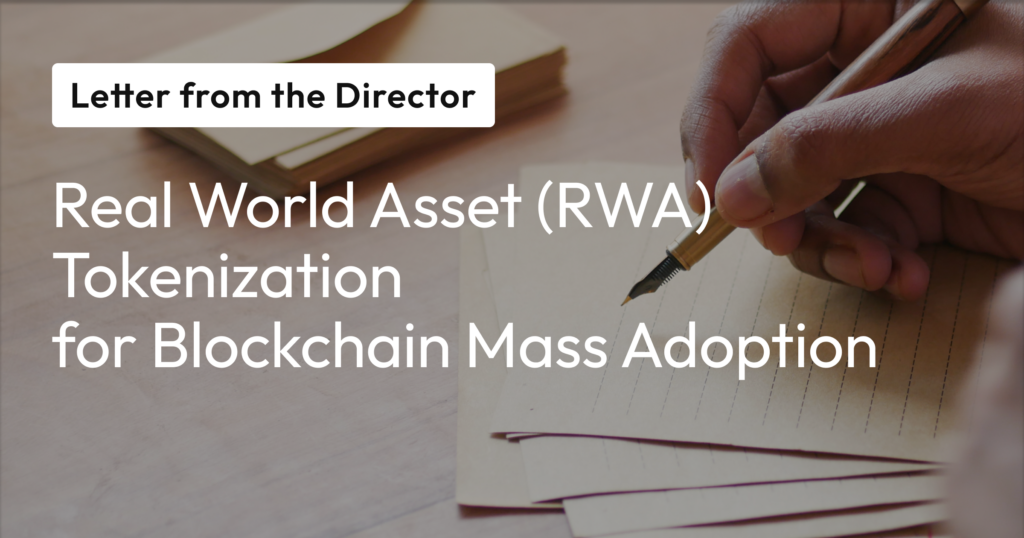Real-World Asset (RWA) Tokenization for Blockchain Mass Adoption

The following is a part of a regular Foundation communique in which Sam shares his thoughts with other Foundation members. The content of the original communique has been repurposed for sharing with the community. We as an organization chose to do this to provide the broader Klaytn community with insights and visibility into how the Klaytn Foundation works as an organization.
Today, I’d like to talk about the direction that we will be steering Klaytn’s ecosystem development towards: the tokenization of real-world assets. There is still much work to be done to accomplish the milestones in Klaytn’s Vision Map, but I’ve put together a letter based on my thoughts and what various teams are working on.
We see the tokenization of real-world assets (RWAs) as a key area where blockchain can contribute to solving the real-world problems we care about. While RWAs are often thought of as just investment assets, they are also intricately linked to issues such as social mobility, housing, the environment, and so on. Through the tokenization of off-chain assets such as currencies, commodities, stocks, carbon credits, real estate, bonds, and artwork, we believe that a more accessible global trading market can be created to contribute towards solving some of these issues.
Like much of the rest of the blockchain industry, Klaytn had been focusing on crypto assets, but we are now looking to tokenize RWAs and expand the ecosystem to make it more relevant to the real world. Crypto assets are intended to create a cryptographically secure store of value or incentive structure in the digital world. While crypto assets have the advantage of being easy to create and manage on-chain and can be segregated by use or purpose, they have the disadvantage of being difficult to create intrinsic value and, as a result, are relatively volatile in price. RWAs on the other hand have a connection with and purpose in the physical world, giving them the advantage of having intrinsic value and relatively low price volatility as they are tied to real world values. However, RWAs also have their own set of challenges, such as off-chain trust issues and regulatory uncertainties regarding their tokenization.
As an on-chain asset, tokenized RWAs can contribute to an increase in TVL (Total Value Locked) and on-chain transactions. They can also contribute to the growth of the ecosystem by expanding the community, increasing on-chain liquidity, and scaling businesses. Tokenization of RWAs is an area of great interest not only to us, but also to the wider blockchain industry, and we believe that Klaytn can lead the global RWA market if we move early in this area. Through RWA tokenization, Klaytn will become a platform that connects the real world and the crypto world, contributing to treasury optimization and creating demand for KLAY, which is one of our goals in the Klaytn Vision Map.
Internally, we have divided RWA tokenization into five types as defined in the RWA Tokenization O2O Matrix above. Here, O2O is an umbrella term for all four conversion passes: off-chain to off-chain, off-chain to on-chain, on-chain to off-chain, and on-chain to on-chain, referring to where the original asset exists and where the market for the tokenized asset will be formed and traded. We plan to start with type 1 in the O2O matrix, “tokenization of off-chain assets and market formation through on-chain,” and gradually expand to others, ultimately making Klaytn an ecosystem where anyone can conveniently trade various types of assets around the world.
As an example, one of the first RWAs that will be tokenized on Klaytn is gold. Gold is a representative physical asset that has been used as a store of value since time immemorial. However, in today’s fast moving markets, the difficulty of storing and moving physical gold creates a barrier to trading, and financial products that attempt to overcome this, such as gold banking and gold ETFs, are hampered by high transaction costs and fees.
The tokenization of gold on Klaytn will be led by our new GC member CREDER, which is a joint venture between ITSEN Group, a Korean IT services company and operator of the Korea Gold Exchange, and BPMG, a blockchain technology company. CREDER will be working to develop a physical gold-based digital asset finance platform service, issue GPC (Gold-pegged Coin) tokens which is a gold-based RWA digital asset, and develop various decentralized financial services utilizing GPC. CREDER plans to contribute to the expansion of the Klaytn ecosystem by supporting RWA token issuance and liquidity enhancement, and by expanding the use of RWA tokens within Klaytn.
While these RWA projects will be primarily undertaken by builders and partners in our ecosystem, Klaytn Foundation has prepared a comprehensive supporting system to streamline and accelerate the tokenization of RWAs, from token-based product development to token issuance, asset holding and trading. Through tokenized RWAs, we plan to bridge the gap between the physical world and the crypto world, creating real-world blockchain use cases that will drive mass adoption.
Until next time,
Sam Seo
Representative Director, Klaytn Foundation
